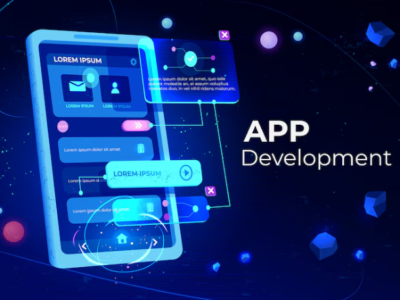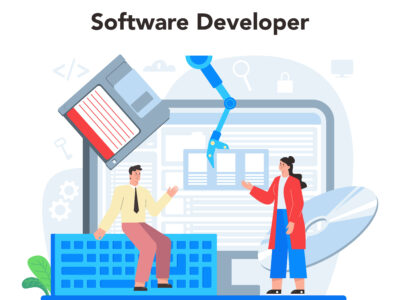
Healthcare IT Market Overview
The Healthcare IT industry includes a diverse set of technology and services aimed at improving the quality, efficiency, and cost-effectiveness of healthcare delivery. It consists of electronic health records (EHRs), telehealth services, healthcare analytics, and Healthcare Application Development, among others. The market is being driven by the growing need for effective healthcare services, the rising prevalence of chronic diseases, and the expanding use of innovative healthcare technologies. Regulatory mandates for health IT systems, as well as the necessity to keep healthcare costs under control, all contribute to market growth.
Healthcare IT Market Size
The Healthcare IT market has been rapidly expanding, indicating the sector’s growing relevance. The global Healthcare IT market was valued at roughly $280 billion in 2023, and it is expected to reach $600 billion by 2030, with a compound annual growth rate (CAGR) of 10-12%. This expansion is being driven by the growing use of telemedicine, the proliferation of IoT devices in healthcare, and significant investments in digital healthcare infrastructure by both public and commercial organisations.
Healthcare IT Market Analysis
The Healthcare IT market is divided into components (services, software, and hardware), delivery modes (on-premises and cloud-based), and end users (hospitals, ambulatory care centres, diagnostic centres, and home healthcare). The market is influenced by key trends such as the Integration of AI and machine learning for predictive analytics, the emergence of personalised medicine, and the shift to value-based healthcare models. North America presently has the greatest market share due to sophisticated healthcare infrastructure and supportive government regulations, while Asia-Pacific is predicted to see the fastest growth rate due to increased healthcare investments and technological adoption.
Internet of Medical Things (IoMT) Statistics
The Internet of Medical Things (IoMT) is a network of connected devices and software applications that exchange health-related information via the Internet. The IoMT market was valued at approximately $70 billion in 2023 and is predicted to rise to $160 billion by 2028, at a CAGR of 15-17%. The increased usage of wearable devices, remote patient monitoring systems, and smart implants is driving this expansion. The expansion of 5G technology, as well as developments in sensor technology, are improving the capabilities and usage of IoT devices.
Telehealth in Healthcare Market Statistics
Telehealth has grown dramatically, aided by the COVID-19 epidemic. The global telehealth industry was worth around $60 billion in 2023 and is expected to reach $220 billion by 2030, increasing at a CAGR of 18-20%. This expansion is attributable to the need for remote healthcare services, developments in telecommunications technology, and improved patient acceptance of virtual consultations. Telehealth services are being expanded to encompass mental health, chronic illness management, and post-operative care.
Cloud Computing in Healthcare Market Statistics
Cloud computing in healthcare refers to the use of remote servers housed on the internet to store, manage, and process healthcare data. The global cloud computing market in healthcare was valued at approximately $45 billion in 2023 and is predicted to grow to $140 billion by 2030, with a CAGR of 16-18%. Key factors include the demand for scalable data storage systems, enhanced data sharing capabilities, and cost-effectiveness. Cloud-based solutions enable increased security, disaster recovery possibilities, and easier regulatory compliance, making them more appealing to healthcare providers.
To summarise, the Healthcare IT market is expected to grow significantly, driven by technology advancements and rising need for efficient and cost-effective healthcare solutions.
mHealth Adoption Statistics
Mobile health (mHealth) is the use of mobile devices and wireless technology in healthcare. The widespread availability of smartphones and the growing desire for accessible healthcare solutions have fueled the exponential growth of mHealth usage. The global mHealth market was estimated at $55 billion in 2023 and is predicted to reach $150 billion by 2030, increasing at a 15-17% CAGR. Key motivators include the growing use of mobile apps for health monitoring, exercise tracking, and chronic disease management. The growing use of telemedicine and remote monitoring devices during the COVID-19 epidemic has pushed mHealth adoption.
Healthcare IT Based on Region
The Healthcare IT market varies significantly by region, influenced by factors such as healthcare infrastructure, regulatory environment, and technological adoption rates.
- North America: Dominates the market with the largest share, driven by advanced healthcare infrastructure, high adoption of electronic health records (EHRs), and supportive government policies. The presence of major IT companies and ongoing investments in digital health also contribute to this region’s leadership.
- Europe: Holds a significant market share, with robust healthcare systems and regulatory mandates like the General Data Protection Regulation (GDPR) that ensure data security and privacy. Countries like the UK, Germany, and France are at the forefront of healthcare IT adoption.
- Asia-Pacific: Expected to witness the highest growth rate due to increasing investments in healthcare infrastructure, rising demand for advanced healthcare services, and growing awareness of digital health solutions. Countries like China, India, and Japan are key markets.
- Latin America and Middle East & Africa: These regions are gradually adopting healthcare IT solutions, driven by improving healthcare infrastructure and increasing investments. However, challenges such as limited resources and regulatory hurdles still need to be addressed.
Healthcare IT Report Summary
Healthcare Application Development is expanding rapidly due to technology improvements, rising demand for effective healthcare services, and regulatory backing. The industry offers a diverse spectrum of solutions, such as EHRs, telemedicine, healthcare analytics, and mobile health applications. The integration of AI and machine learning, the emergence of personalised medicine, and the transition to value-based care models are among the key trends. The market is divided into components, delivery modalities, end-users, and geographies, with North America dominating market share and Asia-Pacific displaying the most development potential.
Healthcare IT Market Segment Analysis
The Healthcare IT market is segmented into several key components:
- By Component:
- Software: Includes EHRs, practice management software, and clinical decision support systems.
- Hardware: Encompasses medical devices, networking equipment, and data storage solutions.
- Services: Includes consulting, implementation, and support services.
- By Delivery Mode:
- On-Premise: Traditional deployment within healthcare facilities.
- Cloud-Based: Increasingly popular due to scalability, cost-effectiveness, and remote access capabilities.
- By End-Users:
- Hospitals and Clinics: Major adopters of comprehensive healthcare IT solutions.
- Ambulatory Care Centers: Utilize specialized software for outpatient care.
- Home Healthcare: Growing segment with the rise of Remote patient monitoring and telehealth.
Recent Development and Innovation in Healthcare IT Industry
The Healthcare IT industry is witnessing rapid innovation and development, including:
- AI and Machine Learning: Enhancements in predictive analytics, personalized treatment plans, and improved diagnostic accuracy.
- Blockchain Technology: Ensuring secure and transparent patient data management.
- Telemedicine: Expanded capabilities and integration with wearable devices for real-time health monitoring.
- 5G Technology: Enabling faster data transmission, improving telehealth services, and supporting IoT devices.
- Interoperability Solutions: Enhancing the seamless exchange of health information across different platforms and systems.
Adopt Healthcare IT Solutions with BrainerHub Solutions
BrainerHub Solutions provides complete healthcare IT solutions suited to the specific needs of healthcare providers. Our services include the deployment of EHRs, telehealth systems, healthcare analytics, and mHealth applications. We prioritise delivering high-quality, secure, and scalable solutions that improve patient care, streamline operations, and meet regulatory requirements. Our skilled staff maintains up to date on industry trends and technical breakthroughs in order to provide unique and effective healthcare IT solutions. Partner with BrainerHub Solutions to improve healthcare delivery and meet organisational goals.










